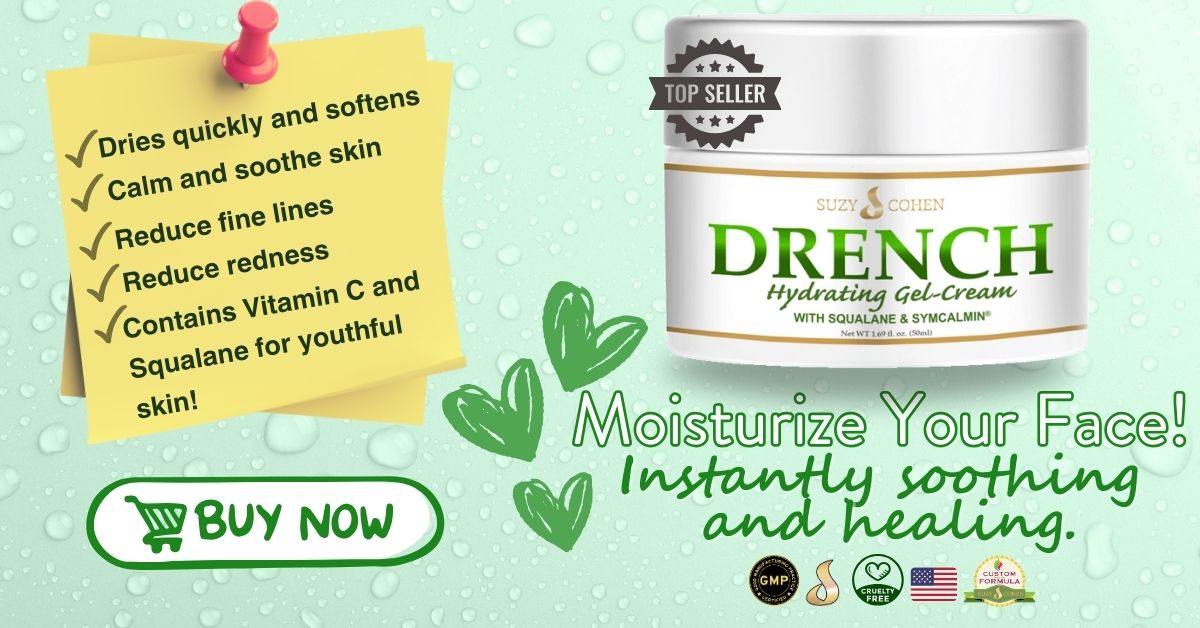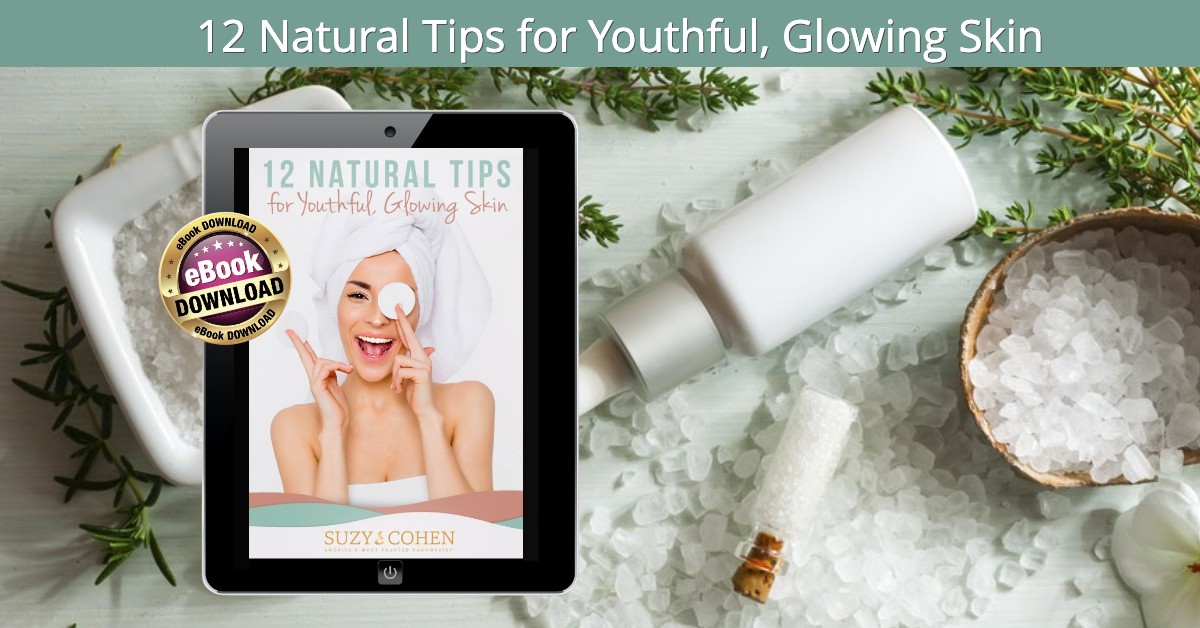What's On This Page?
ToggleWhen you have to do a lot of dishes, laundry, and other household chores, your nail polish isn’t going to stay on very long. Perhaps you’ve turned to using a lot of nail polish, or maybe you go to salons to have them apply the long-wearing shellac/gel nail polish with the UV light.
You may be thinking, “So what? It doesn’t get into my body anyway.”
But it does, and studies prove it. Certain chemicals in nail polish can be easily absorbed into the body. So the main point I’d like to make today is that whatever you expose your fingertips and fingernails to does actually get into your bloodstream. Today’s article is devoted to finding out what’s in your nail polish, and I’ll offer some tips to help you cut down on chemical exposure.
We know it’s a big problem because huge, beloved brand names (ie Orly, OPI, and others) have gone to great lengths to reformulate their nail lacquers to avoid the “toxic trio.”
The toxic trio consists of these nefarious compounds: Formaldehyde, Toluene, and Dibutyl Phthalate (DBP).
I’m not saying those brands are chemical-free entirely, nor am I promoting them. I’m saying they have spent time and money to reformulate their lacquers as a precaution for users, thereby getting rid of 3 chemicals with well-documented dangers. There are many ‘clean’ brands today as compared to 10 years ago.
Does doing your nails pose a health problem for you?
It depends on what you are doing to them.
1) Are you having acrylic dips put on them, or are you using shellac gel polish which contains acrylates as part of the formula?
2) Are you just painting regular nail polish on them, and is it nontoxic nail polish?
The answer to that question is important. And in case you’re wondering, #2 is much safer than #1 in my humble opinion. I say that due to less exposure to acrylates and chemicals with #2.
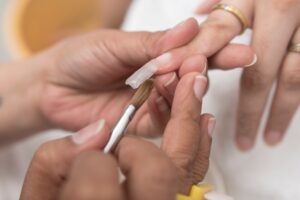
Forget my opinion, let’s talk facts. Have you ever sat in a salon that smells acrid? After 10 minutes, your eyes start to water, or your throat itches, or something else… if you’ve noticed that bad smell, go elsewhere. Your respiratory tract is a sponge and is absorbing all those chemicals, even if you are sitting in there having them apply your own bottle of nontoxic nail polish!
Some nail polish chemicals have an impact on the endocrine system that may translate to disease, and it’s possible that it never gets traced back.
We know that BENZOPHENONE can negatively impact the endocrine system and organs. We also know the toxic trio (formaldehyde, toluene, and DPB) is bad. We also know for sure formaldehyde is harmful, and can adversely affect the lungs. Allergic dermatitis is one other possibility for sensitive folks.
Many people are sensitive to chemicals whether they know it or not. They may not realize that scented candles or perfumes are causing headaches.
We also know that allergic dermatitis and respiratory difficulties are rather common, especially in salons that have a strong acrid odor.
What about acetone?
People who use shellac/gel nail polish have greater exposure to acetone which removes nail polish. Dipping your fingers in acetone (or having them wrapped) can potentially cause problems due to the length of exposure to the acetone and systemic absorption through the skin. It’s one thing to wipe your nail with acetone and another to wrap it in acetone for 5 or 7 minutes.
I have tried shellac polish, I see the pros! It’s the kind that they put on you with a UV light. The pro is that the polish will stay on for at least one week, usually two. The con is the expense. Another con that you probably don’t know about is that it may increase levels of harmful chemicals in your body.
If you’re unable to metabolize and clear these chemicals, then DNA damage and aberrant cell proliferation could theoretically occur. We are not the first generation to ponder what’s in their nail polish, and hair color for that matter. Beauty products often come with harsh chemicals and we don’t even think about it! Yet, if used long enough, or constantly, these oxidants damage cells in the reproductive organs, blood, thyroid, and bones.
Keep in mind that the chemicals I list below are not in every single brand, you have to read the ingredient list to be 100% sure of what is in your brand. If you’re interested in natural beauty, read my article entitled, The Truth About Moisturizers, Serums and Sleep Masks Exposed!
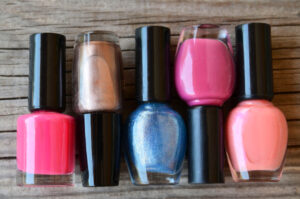
What’s in your nail polish?
1. The main ingredient in most polish is nitrocellulose. This ingredient is in other industries to add a beautiful finish to furniture or musical instruments. Not to alarm you but it’s highly flammable and is found in explosives. Sometimes it’s in other products too, as an example, to bind staples together or to coat glossy playing cards. It’s not considered as harmful as the next three ingredients which are commonly found in most polish brands.
2. Formaldehyde is commonly found in nail polish and strengtheners. Sometimes they change the name to “formalin” or “methylene glycol” so it’s not as easy to spot. Formaldehyde bonds with keratin in your nails, making them temporarily harder.
3. Toluene – This toxin is found in hair dyes too! It’s commonly found in nail polish and may cause breathing problems, headaches, dizziness, and endocrine-related reproductive harm. Toluene is classified as a category 3 toxin, which harms reproductive tissue.
That’s why they took toluene out of some nail polish brands in America, but not all. I believe Orly, OPI, and Sally Hansen have removed toluene from all their nail polishes. The chemical is actually banned in the European Union.
If you’d like more information on the dangers of toluene, here’s an interesting paper from Cosmetics for Safe Cosmetics.
4. Dibutyl Phthalate – This is a type of “phthalate” and we know that phthalates are potentially harmful to the human body and developing babies. Phthalates are strong endocrine disruptors and have a lot of documentation about how they can negatively impact reproductive tissue and neurological systems. Children are particularly vulnerable to phthalates which destroy cells.
Exposure to this particular DPB chemical is known to trigger headache, dizziness, nausea, and possibly seizures if it’s in high enough doses. This is why DPB is one of the 3 chemicals in the toxic trio. It’s also why it has been taken out of some brands of polish.
A PAPER published in June 2022 stated that “Inhalation exposure, at high levels, of dibutyl phthalate may include irritation of the eyes, nose and throat. It may cause nausea, tearing of the eyes, vomiting, dizziness, and headache. Long-term exposures may cause liver and kidney damage. Dibutyl phthalate may harm the developing fetus and the male testes.”
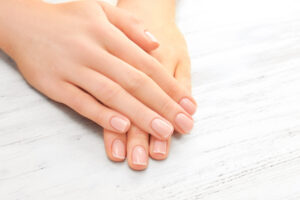
Tips for naturally healthy beautiful nails
The following tips will help you achieve more beautiful hands and nails with much less toxic chemical exposure.
1. Wear gloves. It’s so easy – when you do dishes or chores wear some gloves to protect your nails. This reduces breakage, and it reduces the frequency of needing to e-polish. In turn, it lowers your chemical exposure.
2. Breathe clean, chemical-free air. If you aren’t painting your own nails, then find a local salon that smells fresh and chemical-free. Many of them have a strong odor that hits you when you walk in the door. Minimizing the inhalation of chemicals is particularly important if you already have a chronic illness, such as cancer because your antioxidants are busy detoxing enough cellular debris. The addition of inhaling nail salon chemicals may overwhelm your antioxidant enzymes.
So find a salon that does not have an odor, especially if the strong aroma of nail lacquers bothers your eyes or gives you a headache. That’s a normal sign your body is immediately reacting to the exposure. The residual long-term changes in the body, the lungs, breasts, and the thyroid gland are very hard to discern.
3. Use nontoxic nail polish. Find quality brands that contain fewer chemicals. When making a purchase for nail color, choose nontoxic nail lacquers in order to avoid the Toxic Trio. safer for one’s general health to use nontoxic polish colors on your nails, and formaldehyde-free nail strengtheners, base coats, and top coats because you will be avoiding exposure to toluene, formaldehyde, DPB.
4. Opt for a regular manicure. It’s best to do regular manicures as opposed to shellac ones which use acrylates and special bonding agents and chemicals. Regular manicures don’t last nearly as long as shellac, however, you are not exposed to acrylate chemicals and all the acetone during the removal process. For that matter, what’s wrong with natural nails? We don’t actually need to polish our nails.
There are changes in organic acids that can overwhelm your detoxification pathways. This topic goes beyond the scope of this article, so I am giving it an honorable mention here so you know there could be a build-up of certain toxins in your body.
You can even take it a step further and bring your own nontoxic nail polish to the salon, and have them apply it to your nails. I still strongly suggest a regular mani versus the shellac. Perhaps this is due in part to my friend having constant lung scans now, they can’t figure out what’s wrong with her (yet). She frequents salons that use acrylic and applies it to her nails every two weeks like clockwork.
Shellac itself isn’t the problem alone. With this process, you must soak your nails (or fingertips) in pure acetone for several minutes to remove the old polish! It can dehydrate the nail bed and cuticles, as well as the surrounding skin. There is transdermal absorption!
5. Use non-acetone nail polish remover. Most people are not sensitive to this, but if you are, breathing in even moderate amounts for 10 minutes can irritate your upper respiratory tract and eyes. It can give you a headache, dizziness, vertigo, and nausea. In higher amounts, it can shorten a menstrual cycle! There are many brands of non-acetone nail polish remover that can be used to remove regular nail polish, but it won’t work on shellac/gel manis.
6. Strengthen your nails naturally. Many people have turned to natural remedies for their hair, skin and nails. In this category, you see people using calcium with or without vitamin D, as well as B-complex vitamins (the most famous of which is biotin), and collagen supplements. There is also collateral value in other products such as natural VITAMIN C and Silica (found in horsetail herb). I do see value in these products and use some of them myself for healthy hair, skin and nails.
7. Take a detox supplement afterward. I have a couple of friends who are breast cancer survivors that insist on shellac nail manicures. They just want pretty nails and enjoy being spoiled at the salon. Because these ladies refuse to use nontoxic nail polish or get a regular manicure, I suggested a supplement for them. More specifically I suggested they come home after the treatment and take a detox supplement, and take it for 2 – 3 days. Something so simple as this could help rid the body of harmful, DNA-damaging pro-oxidant chemicals.
After acrylic/shellac/gel nail treatments or hair color treatments I suggest these:
NAC (N acetylcysteine) – this turns into L-cysteine which is required to make glutathione
* L-cysteine – this helps forms glutathione in the cells (you wouldn’t need NAC if you take this one)
Glutathione – this is an antioxidant that helps clear free radicals
Catalase – this helps clear peroxide and formaldehyde (found in nail polish)
Water – drink a lot of pure filtered water
Superfood green drinks – greens are known for their ability to detoxify
*If you take L-cysteine, you don’t need the precursor NAC. It is one or the other!
Thyroid Connection and Nails
Research has shown that certain chemicals commonly found in nail salon products, including nail polish, polish removers, hardeners, and materials used for artificial nails, can have endocrine-disrupting properties. These substances can potentially affect thyroid function, among other hormonal systems in the body. The disruptions can potentially contribute to and worsen both hypothyroidism and hyperthyroidism. Of the nail polish chemicals, the ones of most concern are:
- Phthalates (especially Dibutyl Phthalate, DBP): Used in nail polishes to increase flexibility and prevent cracking, phthalates have been linked to endocrine disruption in various studies. DBP, in particular, has been associated with thyroid function alterations.
- Toluene: Found in nail polish and polish removers, toluene helps create a smooth application and finish but is also linked to nervous system toxicity and potential thyroid disruption.
Formaldehyde: Used in some nail strengtheners and many brands of nail polish, formaldehyde is a known carcinogen and may have an impact on hormone function. - Methacrylate compounds: Used in artificial nails and gel nails, these compounds can cause allergic reactions and have been explored for their potential endocrine-disrupting effects.
What about the workers? The occupational exposure of nail salon workers to these chemicals has been a particular area of concern. Workers in nail salons are often exposed to high levels of these potentially harmful chemicals daily, raising questions about long-term health effects, including thyroid and other endocrine diseases.
Direct causality is difficult to prove, so there is nothing definite about the cumulative exposure. We just know that sometimes factors like individual susceptibility, and genetic factors play a role with individualls and their thyroid illness. Given the potential risks, you may choose to seek out nail products labeled as “free” from certain harmful chemicals (e.g., “3-free,” “5-free,” or “7-free,” indicating the absence of specific numbers of these chemicals). These alternatives can potentially reduce exposure to endocrine-disrupting chemicals.
Closing statements about nail polish
Studies have not confirmed that a person is healthier during their lifetime because they avoid nail polish and acetone. Likewise, studies have not confirmed that you get a disease from these beauty items either! So take these tips into consideration and do what you think is right for you.
You may be wondering about me. I do use nail polish sometimes and when I go to the local salon, I get a regular mani not the bells and whistles (ie shellac/gel) which come with too many chemicals.
So I don’t want you to feel like I’m anti-nails! On the contrary, I’m actually a beauty junkie myself and love to formulate skincare products now. I’m obsessed with using clean ingredients for my skincare formulations. You may not realize this, but the FDA doesn’t require those cosmetics ever get tested for long-term effects before coming to market, so you have to trust the maker to not put junk in there.
You can get this free ebook below and visit my website to see what products I make. But I like clean, hypoallergenic, nontoxic makeup and skincare because there is no risk with those.
If you’re exposing yourself to hair dyes, nail treatments with acrylic, or other beauty treatments that include chemicals, then keep in mind frequency matters. If you’re doing your nails every week and dying your hair every month, your level of exposure is high. Limiting exposure limits toxic load.

Suzy Cohen, has been a licensed pharmacist for over 30 years and believes the best approach to chronic illness is a combination of natural medicine and conventional. She founded her own dietary supplement company specializing in custom-formulas, some of which have patents. With a special focus on functional medicine, thyroid health and drug nutrient depletion, Suzy is the author of several related books including Thyroid Healthy, Drug Muggers, Diabetes Without Drugs, and a nationally syndicated column.
